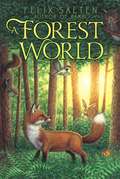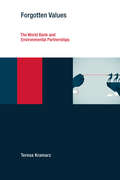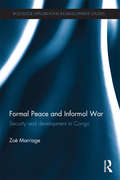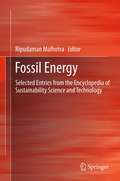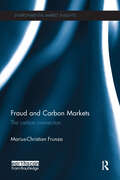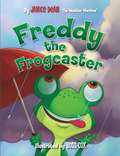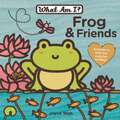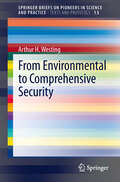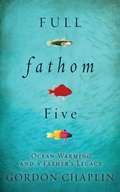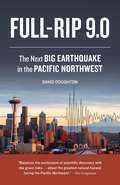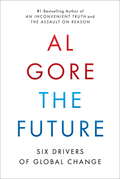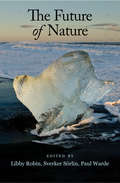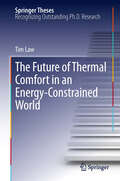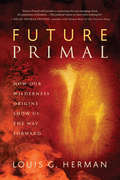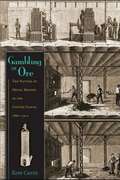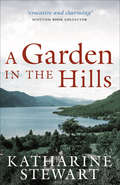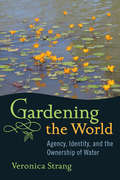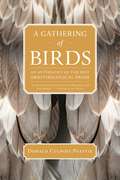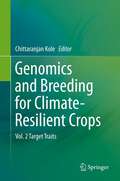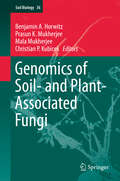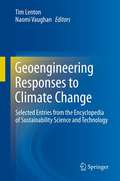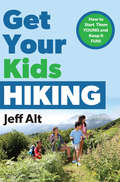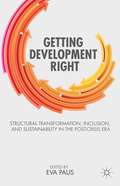- Table View
- List View
A Forest World
by Felix SaltenThe forest is a whole different world. . . Felix Salten's classic story of wild and tame animals coming together is brought vividly to life in this refreshed edition. To the animals of Lodge Farm, the woods are a forbidden place filled with danger and uncertainty. For the wild animals in the forest, the farm is just as frightening, because Man lives there. The two worlds are next to one another, but couldn't be further apart. When the groups, tame and wild, begin to interact, each begins to question how life would be different on the other side. Manni the donkey ventures into the forest for an adventure, while a doe and her two fawns seek the safety of the barn when poachers threaten them in the woods. Will the animals choose to stay in their new lives? Or will the call of home be too great?
Forgotten Values: The World Bank and Environmental Partnerships (Earth System Governance)
by Teresa KramarzAn examination of the conflict between values and bureaucracy in World Bank biodiversity partnerships that sheds light on this model of global environmental governance.Multi-stakeholder partnerships have become an increasingly common form of global governance. Partnerships, usually between international organizations (IOs) or state agencies and such private actors as NGOs, businesses, and academic institutions, have even been promoted as the gold standard of good governance--participatory, innovative, and well-funded. And yet these partnerships often fail to live up to the values that motivated their establishment. In this book, Teresa Kramarz examines this gap between promise and performance by analyzing partnerships in biodiversity conservation initiatives launched by the World Bank.
Formal Peace and Informal War: Security and Development in Congo (Routledge Explorations in Development Studies)
by Zoë MarriageNorthern interventions into African countries at war are dominated by security concerns, bolstered by claims of shared returns and reinforcing processes of development and security. As global security and human security became prominent in development policy, Congo was wracked by violent rule, pillage, internal fighting, and invasion. In 2002, the Global and All-Inclusive Peace was promoted by northern donors, placing a formal peace on the mass of informalised wars. Formal Peace and Informal War: Security and Development in Congo examines how the security interests of the Congolese population have interacted with those of northern donors. It explores Congo’s contemporary wars and the peace agreed on in 2002 from a security perspective and challenges the asserted commonality of the liberal interventions made by northern donors. It finds that the peace framed the multiple conflicts in Congo as a civil war and engineered a power-sharing agreement between elite belligerents. The book argues that the population were politically and economically excluded from the peace and have been subjected to control and containment when their security rests with power and freedom.
Fossil Energy
by Ripudaman MalhotraThe word sustainability shares its root with sustenance. In the context of modern society, sustenance is inextricably linked to the use of energy. Fossil Energy provides an authoritative reference on all aspects of this key resource, which currently represents nearly 85% of global energy consumption. Gathering 16 peer-reviewed entries from the Encyclopedia of Sustainability Science and Technology, the chapters provide comprehensive, yet concise coverage of fundamentals and current areas of research. Written by recognized authorities in the field, this volume represents an essential resource for scientists and engineers working on the development of energy resources, fossil or alternative, and reflects the essential role of energy supplies in supporting a sustainable future.
Fraud and Carbon Markets: The Carbon Connection (Environmental Market Insights)
by Marius-Christian FrunzaThe VAT Carousel Fraud has seriously undermined the financial integrity of the European Union Emissions Trading Scheme (EU ETS). This timely book is the first to give an overview of fraud in the carbon market. Written by a former broker, it presents unique material on the carbon fraud mechanics and analyses the missing trader fraud (VAT fraud) on European carbon allowances markets with a focus on financial and organised crime issues. Fraud and Carbon Markets: The Carbon Connection assesses the weaknesses of the Kyoto Protocol and environmental markets, using statistics as a forensic tool on the capital markets. It describes specific cases, the court investigations and various mechanisms. It addresses issues of money laundering and international fraud on capital markets, such as stock manipulation, by exploring the financial mechanisms of the fraud, their impact on the market behaviour and the consequences on their econometric features. Researchers and students in climate change policy, environmental finance, financial law, organised crime, forensic statistics, financial regulation and risk management as well as financial regulators and policy makers will find this book of great interest.
Freddy the Frogcaster
by Janice DeanFreddy the Frog loves learning about the weather, and he's known for having the best predictions in town. But what happens when the town picnic is almost ruined by a storm that catches the local frogcaster by surprise? Freddie has to step in to save the day! Well-known Fox News broadcast meteorologist Janice Dean pens this exciting and hilarious tale about an aspiring weathercaster who can't keep his eyes off the sky. Children and adults will love the charming frog world Freddy lives in, and the fun science lessons he shares, with an activities section in the back
Friends of the Earth: A History of American Environmentalism with 21 Activities (For Kids series #42)
by Pat MccarthyThe history of American environmentalism is the history of men and women who dedicated their lives to protecting the nation's natural heritage. Almost singlehandedly, John James Audubon introduced the study of birds in North America. John Muir pushed a president and a nation into setting aside vast preserves, including Yosemite, Sequoia, Mt. Rainier, and the Grand Canyon. Marjory Stoneman Douglas did the same for the Florida Everglades, as did Mardy Murie with the Grand Tetons and the Arctic National Wildlife Refuge. Cordelia Stanwood, and later Roger Peterson, revolutionized and popularized birdwatching. Rachel Carson opened the world's eyes to the dangers of pesticides, and Julia "Butterfly" Hill saved a 1,000-year-old redwood while bringing to light the devastation of our old growth forests. Together, these environmentalists' inspiring life stories tell the story of American environmentalism, from its inception to the present day. In Friends of Our Earth readers will also learn how to put their concerns into action. Author Pat McCarthy gives step-by-step instructions on how to build a birdfeeder, conduct a water quality survey, start a compost pile, study the Greenhouse Effect, make plaster casts of animals tracks, create their own recycled paper, test for acid rain, and more. It includes a time line of historic milestones, popular outdoor parks and sites to visit or explore online, and Web resources for further study.
Frog & Friends
by Joyce WanI swim with the fish, hop with the frogs, and paddle with the ducks. What am I? Children are asked to figure out just who does all these things in this delightful, bright book. A beautiful spread at the end reveals it&’s a lovely pond.
From Environmental to Comprehensive Security
by Arthur H. WestingThis work presents the evolution of the traditional concept of "national security" as military security to additionally embrace "environmental security" and then necessarily also "social (societal) security", thence to be termed "comprehensive human security". It accomplishes this primarily by presenting 11 of the author's own benchmark papers published between 1983 and 2010 (additionally providing bibliographic citations to a further 36 of the author's related publications during that period). The work stresses the importance of transfrontier (regional) cooperation, and also recognizes global overpopulation as a key impediment to achieving comprehensive human security.
Full Fathom Five
by Gordon ChaplinGordon Chaplin's father was a seemingly happy-go-lucky, charismatic adventurer who married a wealthy heiress and somehow transformed himself into the author of a landmark scientific study, Fishes of the Bahamas, published by the Academy of Natural Sciences of Philadelphia. As a young boy, the author took part in collecting specimens for his father. Fifty years later, he was asked to join a team from the same institution studying the state of sea life in the Bahamian waters where he grew up, as measured against his father's benchmark. The first of the sea changes presented in this eloquent book stems from climate change and is the drastic transformation of ocean life due to global warming. The second is his father's miraculous transformation from presumed playboy into scientist. And the third involves the author's own complicated relationship with his parents and in particular his father, as he grew older and assumed the part of the prodigal son. Fifty years later, returning to his childhood home, he delves into the mysteries of his father's life and the impossibility of ever truly recovering the past, or ever returning home.Illustrated with gorgeous color plates from the original Fishes of the Bahamas and featuring descriptions of exquisite undersea beauty and heartrending devastation, this is a status report on climate change unlike any other, both a report from the field and an intensely personal reckoning.
Full-Rip 9.0: The Next Big Earthquake in the Pacific Northwest
by Sandi DoughtonScientists have identified Seattle, Portland, and Vancouver as the urban centers of what will be the biggest earthquake--the Really Big One--in the continental United States. A quake will happen--in fact it's actually overdue. The Cascadia subduction zone is 750 miles long, running along the Pacific coast from Northern California up to southern British Columbia. In this fascinating book, The Seattle Times science reporter Sandi Doughton introduces readers to the scientists who are dedicated to understanding the way the earth moves and describes what patterns can be identified and how prepared (or not) people are. With a 100% chance of a mega-quake hitting the Pacific Northwest, this fascinating book reports on the scientists who are trying to understand when, where, and just how big THE BIG ONE will be.From the Trade Paperback edition.
The Future: Six Drivers of Global Change
by Al GoreFrom the former vice president and #1 New York Times bestselling author comes An Inconvenient Truth for everything--a frank and clear-eyed assessment of six critical drivers of global change in the decades to come. Ours is a time of revolutionary change that has no precedent in history. With the same passion he brought to the challenge of climate change, and with his decades of experience on the front lines of global policy, Al Gore surveys our planet's beclouded horizon and offers a sober, learned, and ultimately hopeful forecast in the visionary tradition of Alvin Toffler's Future Shock and John Naisbitt's Megatrends. In The Future, Gore identifies the emerging forces that are reshaping our world: * Ever-increasing economic globalization has led to the emergence of what he labels "Earth Inc."--an integrated holistic entity with a new and different relationship to capital, labor, consumer markets, and national governments than in the past. * The worldwide digital communications, Internet, and computer revolutions have led to the emergence of "the Global Mind," which links the thoughts and feelings of billions of people and connects intelligent machines, robots, ubiquitous sensors, and databases. * The balance of global political, economic, and military power is shifting more profoundly than at any time in the last five hundred years--from a U.S.-centered system to one with multiple emerging centers of power, from nation-states to private actors, and from political systems to markets. * A deeply flawed economic compass is leading us to unsustainable growth in consumption, pollution flows, and depletion of the planet's strategic resources of topsoil, freshwater, and living species. * Genomic, biotechnology, neuroscience, and life sciences revolutions are radically transforming the fields of medicine, agriculture, and molecular science--and are putting control of evolution in human hands. * There has been a radical disruption of the relationship between human beings and the earth's ecosystems, along with the beginning of a revolutionary transformation of energy systems, agriculture, transportation, and construction worldwide. From his earliest days in public life, Al Gore has been warning us of the promise and peril of emergent truths--no matter how "inconvenient" they may seem to be. As absorbing as it is visionary, The Future is a map of the world to come, from a man who has looked ahead before and been proven all too right.
The Future of Nature
by Paul Warde Sverker Sorlin Libby RobinThis anthology provides a comprehensive overview of the science behind environmental prediction and how, as predictions about environmental change have been taken more seriously and widely, they have affected politics, policy, and public perception. Through an array of texts and commentaries that examine the themes of progress, population, environment, biodiversity, and sustainability from a fully global perspective, it shows how twenty-first century predictors think about what forecasting the future means. Providing access and reference points to the origins and development of key disciplines and methods, it will encourage policy makers, professionals, and students to reflect on the roots of their own theories and practices.
The Future of Thermal Comfort in an Energy- Constrained World
by Tim LawThe dissertation investigates the scientific and business factors that have resulted in air-conditioning being a major contributor to climate-change. With his architectural background, the author demonstrates how a design methodology, not commonly adopted in scientific studies, may actually be a suitable way of dealing with a complex problem: the 'business as usual' scenario involving building science, sociological values and consumer behavior. Using his innovations as case studies, the author shows how good ideas cannot be evaluated on scientific merit alone and demonstrates why commercialization may have a pivotal role in deployment of research-based technology. He advances the theory of personalized thermal comfort which can potentially resolve the air-conditioning conundrum.
Future Primal
by Louis G. HermanHow should we respond to our converging crises of violent conflict, political corruption, and global ecological devastation? In this sweeping, big-picture synthesis, Louis G. Herman argues that for us to create a sustainable, fulfilling future, we need to first look back into our deepest past to recover our core humanity. Important clues for recovery can be found in the lives of traditional San Bushman hunter-gatherers of South Africa, the closest living relatives to the ancestral African population from which all humans descended. Their culture can give us a sense of what life was like during the tens of thousands of years when humans lived in wilderness, without warfare, walled cities, or slavery. Herman suggests we draw from the experience of the San and other earth-based cultures and weave their wisdom together with the scientific story of an evolving universe to help create something radically new -- an earth-centered, planetary politics with the personal truth quest at its heart.
Gambling on Ore: The Nature of Metal Mining in the United States, 1860-1910
by Kent CurtisGambling on Ore examines the development of the western mining industry from the tumultuous and violent Gold Rush to the elevation of large-scale copper mining in the early twentieth century, using Montana as representative of mining developments in the broader US mining west. Employing abundant new historical evidence in key primary and secondary sources, Curtis tells the story of the inescapable relationship of mining to nature in the modern world as the United States moved from a primarily agricultural society to a mining nation in the second half of the nineteenth century.In Montana, legal issues and politics--such as unexpected consequences of federal mining law and the electrification of the United States--further complicated the mining industry's already complex relationship to geology, while government policy, legal frameworks, dominant understandings of nature, and the exigencies of profit and production drove the industry in momentous and surprising directions. Despite its many uncertainties, mining became an important part of American culture and daily life. Gambling on Ore unpacks the tangled relationships between mining and the natural world that gave material possibility to the age of electricity. Metal mining has had a profound influence on the human ecology and the social relationships of North America through the twentieth century and throughout the world after World War II. Understanding how we forged these relationships is central to understanding the environmental history of the United States after 1850.
A Garden in the Hills
by Katharine StewartThe author of the classic A Croft in the Hills takes us through a year in her Scottish Highlands garden and its many delights. This illustrated book celebrates one of humankind&’s oldest pleasures. Month by month, we are taken through a year in the life of Katharine Stewart&’s garden outside the old schoolhouse in Abriachan, Scotland, where she lives with her husband and daughter. The circle of the seasons is luminously evoked as we are told of the practicalities of gardening, cooking, beekeeping, and winemaking. From a winner of a Saltire Society Award for her contribution to the understanding of Scottish Highland culture, and peppered with warm personal insights, good humor, and a love of living things, this account of the joy of nature reminds us how rewarding it is to be outdoors. &“Evocative and charming.&” —Scottish Book Collector
Gardening The World
by Veronica StrangAround the world, intensifying development and human demands for fresh water are placing unsustainable pressures on finite resources. Countries are waging war over transboundary rivers, and rural and urban communities are increasingly divided as irrigation demands compete with domestic desires. Marginal groups are losing access to water as powerful elites protect their own interests, and entire ecosystems are being severely degraded. These problems are particularly evident in Australia, with its industrialised economy and arid climate. Yet there have been relatively few attempts to examine the social and cultural complexities that underlie people's engagements with water. Based on long-term ethnographic fieldwork in two major Australian river catchments (the Mitchell River in Cape York, and the Brisbane River in southeast Queensland), this book examines their major water using and managing groups: indigenous communities, farmers, industries, recreational and domestic water users, and environmental organisations. It explores the issues that shape their different beliefs, values and practices in relation to water, and considers the specifically cultural or sub-cultural meanings that they encode in their material surroundings. Through an analysis of each group's diverse efforts to 'garden the world', it provides insights into the complexities of human-environmental relationships.
A Gathering of Birds
by Donald Culross PeattieA Gathering of Birds is an anthology containing selected prose about birds by nineteen famous authors, such as Hudson, Audubon, and Thoreau, and includes brief biographical information about each. The New York Times called the collection "a delightful 'gathering' that Mr. Peattie has presented, and his own contributions to the book make it something new and valuable in this field."
A Gathering of Birds
by Donald Culross PeattieA Gathering of Birds is an anthology containing selected prose about birds by nineteen famous authors, such as Hudson, Audubon, and Thoreau, and includes brief biographical information about each. The New York Times called the collection "a delightful 'gathering' that Mr. Peattie has presented, and his own contributions to the book make it something new and valuable in this field."
Genomics and Breeding for Climate-Resilient Crops: Vol. 2 Target Traits
by Chittaranjan KoleClimate change is expected to have a drastic impact on agronomic conditions including temperature, precipitation, soil nutrients, and the incidence of disease pests, to name a few. To face this looming threat, significant progress in developing new breeding strategies has been made over the last few decades. The second volume of Genomics and Breeding for Climate-Resilient Crops describes various genomic and breeding approaches for the genetic improvement of the major target traits. Topics covered include: flowering time; root traits; cold, heat and drought tolerance; water use efficiency; flooding and submergence tolerance; disease and insect resistance; nutrient use efficiency; nitrogen fixation; carbon sequestration; and greenhouse gas emissions.
Genomics of Soil- and Plant-Associated Fungi
by Mala Mukherjee Prasun K. Mukherjee Benjamin A. Horwitz Christian P. KubicekThis volume addresses the similarities and also the differences in the genomes of soil saprophytes, symbionts, and plant pathogens by using examples of fungal species to illustrate particular principles. It analyzes how the specific interactions with the hosts and the influence of the environment may have shaped genome evolution. The relevance of fungal genetic research and biotechnological applications is shown for areas such as plant pathogenesis, biomass degradation, litter decomposition, nitrogen assimilation, antibiotic production, mycoparasitism, energy, ecology, and also for soil fungi turning to human pathogens. In addition to the model organisms Neurospora and Aspergillus, the following species are covered providing a view of pathogens and mutualists: Trichoderma, Fusarium oxysporum, Cochliobolus heterostrophus, Penicillium chrysogenum, Rhizopus oryzae, Podospora anserina, Agaricomycetes, Archaeorhizomycetes and Magnaporthaceae. Ecology and potential applications have guided the choice of fungal genes to be studied and it will be fascinating to follow the trends of future sequencing projects.
Geoengineering Responses to Climate Change
by Naomi Vaughan Tim LentonFailure by the international community to make substantive progress in reducing CO2 emissions, coupled with recent evidence of accelerating climate change, has brought increasing urgency to the search for additional remediation approaches. This book presents a selection of state-of-the-art geoengineering methods for deliberately reducing the effects of anthropogenic climate change, either by actively removing greenhouse gases from the atmosphere or by decreasing the amount of sunlight absorbed at the Earth's surface. These methods contrast with more conventional mitigation approaches which focus on reducing emissions of greenhouse gases, especially carbon dioxide. Geoengineering technologies could become a key tool to be used in conjunction with emissions reduction to limit the magnitude of climate change. Featuring authoritative, peer-reviewed entries from the Encyclopedia of Sustainability Science and Technology, this book presents a wide range of climate change remediation technologies.
Get Your Kids Hiking: How to Start Them Young and Keep it Fun!
by Jeff AltHiking is a great way to relax, connect with nature, and enjoy time with your family. Bringing your kids along can be rewarding for you and for them, but it can also add new challenges and concerns to your trip. Get Your Kids Hiking is loaded with everything you need to know to hit the trail with kids; from gear to simple proven techniques that will make your hike safe and fun. Written with both the novice and the seasoned hiker in mind, Jeff Alt provides all the information you need to take your child out on the trail.This books offers:Age-appropriate ways to include your child in all aspects of the hikeChecklists of what to pack for any type of hikeKid-friendly menusAdvice for hiking with a child who has special needs.Get Your Kids Hiking is the playbook to inspire an appreciation for the great outdoors in your children and keep your young child or teenager interested in a family hiking trip.
Getting Development Right
by Eva PausThe celebratory tone about the emergence of the BRICs and the improved growth in Sub Saharan Africa and Latin America during the 2000s obscures the reality that, for large parts of the developing world, the development challenges are more acute than ever before. After three decades of Washington Consensus policies, deepening globalization, and China's and India's increasing competitiveness in ever more goods and services, many developing countries are now facing three critical challenges: how to engender a transformation of the production structure that creates many more productive jobs, how to make growth more inclusive, and how to stimulate a growth process compatible with environmental sustainability. This book brings together development scholars and practitioners from multiple academic disciplines and policy perspectives to analyze important facets of this triple challenge, to explore interconnections among them and suggest strategies for overcoming the challenges in the current age of globalization. Three features distinguish this book from other current works in the field. First, this book looks beyond the current global crisis and short-term growth opportunities and analyzes the challenges to development from a long-term perspective. Second, books on the barriers to development tend to concentrate on one of the three challenges, e. g. Barbier (2010) A Global Green New Deal on environmental sustainability; Cimoli, Dosi, Stiglitz (2009) Industrial Policy and Development on structural transformation; and Milanovic (2011) The Have and the Have-Nots on exclusion. This book, in contrast, brings the three challenges together to emphasize that they challenges are interlinked and that strategies and policies must begin to recognize these interconnections to address different aspects of the challenges concomitantly. Finally, the contributors to the book include some of the most renowned development thinkers of our time.
